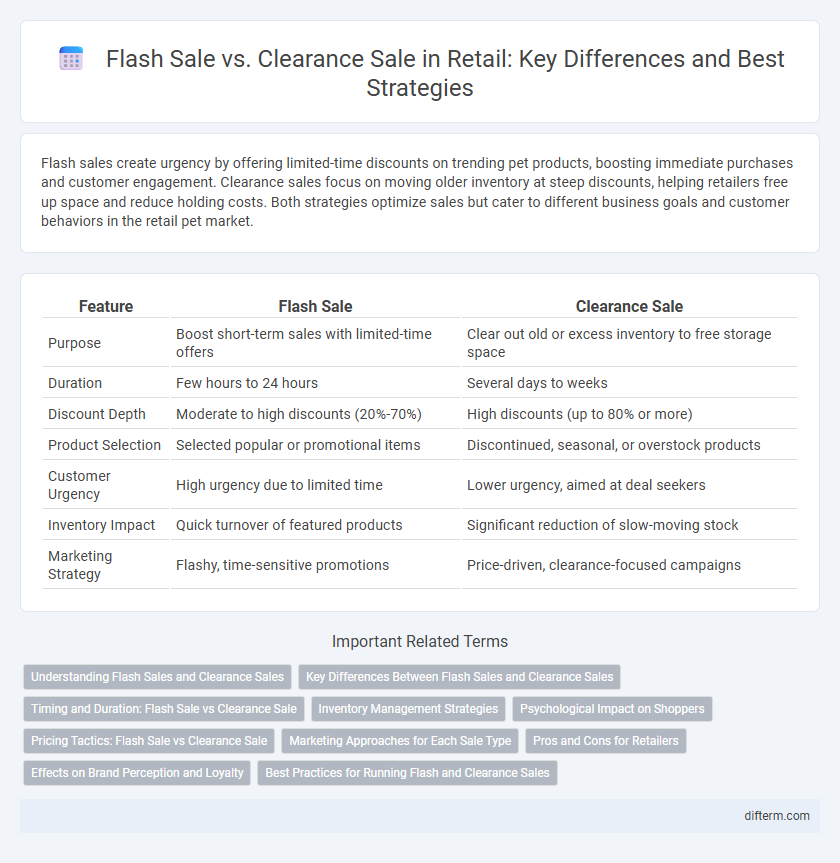Flash sales create urgency by offering limited-time discounts on trending pet products, boosting immediate purchases and customer engagement. Clearance sales focus on moving older inventory at steep discounts, helping retailers free up space and reduce holding costs. Both strategies optimize sales but cater to different business goals and customer behaviors in the retail pet market.
Table of Comparison
| Feature | Flash Sale | Clearance Sale |
|---|---|---|
| Purpose | Boost short-term sales with limited-time offers | Clear out old or excess inventory to free storage space |
| Duration | Few hours to 24 hours | Several days to weeks |
| Discount Depth | Moderate to high discounts (20%-70%) | High discounts (up to 80% or more) |
| Product Selection | Selected popular or promotional items | Discontinued, seasonal, or overstock products |
| Customer Urgency | High urgency due to limited time | Lower urgency, aimed at deal seekers |
| Inventory Impact | Quick turnover of featured products | Significant reduction of slow-moving stock |
| Marketing Strategy | Flashy, time-sensitive promotions | Price-driven, clearance-focused campaigns |
Understanding Flash Sales and Clearance Sales
Flash sales offer limited-time discounts on selected products to create urgency and boost immediate purchases, often lasting a few hours to a day. Clearance sales focus on liquidating excess or discontinued inventory at reduced prices to free up shelf space and refresh inventory. Both strategies aim to increase sales velocity but differ in timing, purpose, and discount depth.
Key Differences Between Flash Sales and Clearance Sales
Flash sales offer limited-time discounts on select products, creating urgency to boost short-term sales and attract impulse buyers. Clearance sales target excess or obsolete inventory with deeper discounts to free up shelf space and make room for new stock. Flash sales emphasize rapid, time-sensitive promotions, while clearance sales focus on inventory reduction and long-term stock management.
Timing and Duration: Flash Sale vs Clearance Sale
Flash sales typically occur for a very short duration, often lasting a few hours to a day, creating a sense of urgency to boost immediate sales. Clearance sales are prolonged events, sometimes spanning weeks or months, designed to clear out end-of-season or discontinued inventory. The precise timing of flash sales is often spontaneous or tied to special events, while clearance sales align with inventory cycles and seasonal transitions.
Inventory Management Strategies
Flash sales rapidly clear excess stock by creating urgency with limited-time offers, driving immediate customer purchases and improving cash flow. Clearance sales systematically reduce outdated or seasonal inventory through sustained discounts, optimizing storage space and minimizing holding costs. Effective inventory management balances both methods to maintain product turnover while preserving profit margins and minimizing markdown losses.
Psychological Impact on Shoppers
Flash sales create a sense of urgency by offering limited-time deals, motivating shoppers to make impulsive purchases due to fear of missing out. Clearance sales, often signaling the end of a product line or season, tap into the perception of scarcity and deal-hunting satisfaction, leading customers to feel they are gaining exclusive value. Both strategies leverage scarcity and urgency but differ in emotional triggers: flash sales stress immediacy, while clearance sales evoke a reward-focused mindset.
Pricing Tactics: Flash Sale vs Clearance Sale
Flash sales implement steep, time-limited discounts to create urgency and boost short-term sales, often targeting trending or seasonal products. Clearance sales focus on deeply discounted prices to quickly move excess inventory or discontinued items, prioritizing stock liquidation over profit margins. Retailers leverage flash sales to increase customer engagement and drive immediate traffic, while clearance sales aim to free up storage space and reduce holding costs.
Marketing Approaches for Each Sale Type
Flash sales leverage urgency-driven marketing strategies using limited-time offers and countdown timers to stimulate immediate purchases and capitalize on impulse buying. Clearance sales focus on long-term inventory reduction through deep discounts and targeted promotions aimed at budget-conscious shoppers seeking value. Retailers optimize flash sales with aggressive social media campaigns and email blasts, while clearance sales rely on signage, loyalty programs, and multi-channel advertising to clear excess stock effectively.
Pros and Cons for Retailers
Flash sales create urgency and attract immediate traffic, boosting short-term revenue but often at the cost of lower profit margins and potential brand dilution. Clearance sales help retailers efficiently move outdated inventory, freeing up space for new products, though they may signal overstocking issues and reduce perceived product value. Both strategies require careful planning to balance sales velocity with profitability and customer perception.
Effects on Brand Perception and Loyalty
Flash sales create urgency and excitement, often enhancing brand perception by associating it with value and exclusivity, which can boost short-term customer loyalty. Clearance sales may signal overstock or declining product demand, potentially diminishing brand prestige and eroding long-term loyalty if perceived as frequent or desperate discounting. Balancing flash sales with selective clearance strategies helps maintain a positive brand image and sustained customer trust in retail.
Best Practices for Running Flash and Clearance Sales
Executing successful flash sales requires precise timing, limited inventory, and engaging, time-sensitive promotions to create urgency and boost short-term sales. Clearance sales benefit from clear communication of deep discounts, strategic timing at the end of seasons, and efficient inventory management to maximize space and revenue. Utilizing data analytics to tailor offers and monitor customer response enhances both flash and clearance sale effectiveness in retail environments.
Flash Sale vs Clearance Sale Infographic

 difterm.com
difterm.com